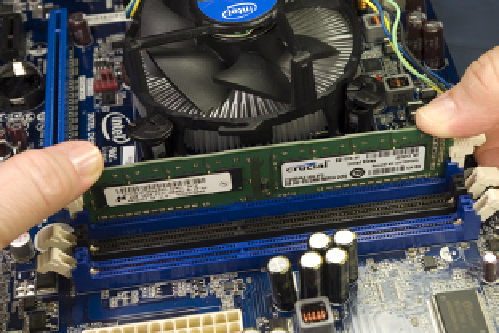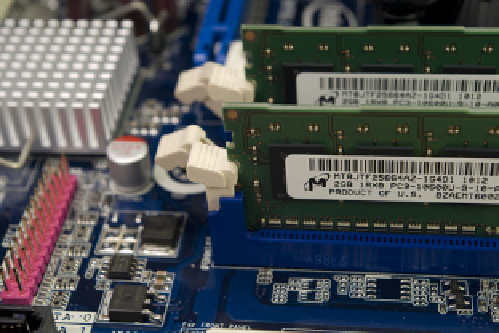Hardware Reference
In-Depth Information
Verify that the DIMM is fully seated, as shown in Figure 4-35. If the DIMM is seat-
ed properly, none of the contacts on the bottom edge of the module should
be visible, and the DIMM latching posts should snap up into the latched posi-
tion. (If the module is fully seated but the DIMM latching posts remain open,
manually close them to engage the notches on the edges of the DIMMs.)
Figure 4-34.
Use both thumbs to press down firmly until the DIMM
snaps into place
Figure 4-35.
Verify that the DIMMs are fully seated and the latch-
ing posts are in the latched position
InstallingtheMotherboard
With the motherboard populated, the next step is to install it in the case.
Ordinarily, we'd have already compared the I/O shield with the motherboard's
back-panel I/O port to make sure they matched and then installed the I/O
shield in the case.
We started to do it that way for this system, but we immediately ran into a
problem. There is so little clearance for the DH55TC motherboard that we sim-
ply couldn't fit the motherboard into the case with the I/O shield installed.
Well, we suppose we could have, but doing that would have required remov-
ing and reinstalling the rear case fan. That we could have done at the cost
of a few extra minutes' work, but it also appeared that we'd have to remove
and replace the shelf that supports the two internal hard drive cages, and that
shelf is riveted.
As we sat there considering our alternatives, our gaze settled on the rear of the
Mini P180 case, shown in Figure 4-36 with the motherboard already installed.
Hmmm. Four expansion slot covers that are mostly holes, and a good-sized
grill to ventilate the expansion slots. A 120 mm fan grill. And that's not even
counting the honking huge 200 mm fan grill at the top rear of the case. This
area of the Antec Mini P180 is mostly open to the air anyway, and we con-
cluded that the small additional gap produced by leaving out the I/O shield
wouldn't noticeably affect air flow, cooling, or noise level. So, for the first time
since Intel introduced the ATX form factor in 1995, we decided to build a sys-
tem without installing the I/O shield. (Later testing showed that both the pro-
cessor and hard drive were running very cool, so we have no concerns about
omitting the I/O shield.)
Figure 4-36.
Leaving out the I/O shield
doesn't greatly increase the open area of
the Antec Mini P180 case



